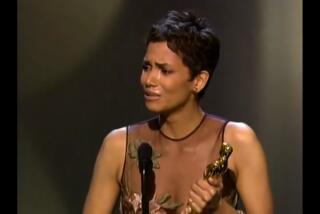Oscars 2016: How one film editor goes from her first action movie, ‘Mad Max: Fury Road,’ to an Oscar nod
The reason South African-born film editor Margaret Sixel and her husband, director George Miller, slept in on the day the Oscar nominations were announced in L.A. is that they were at home in Sydney, Australia. Due to the time difference, they were up past midnight to learn they’d both been nominated. Though she’d collaborated with Miller before — Sixel edited “Babe: Pig in the City” (1998) and “Happy Feet” (2006) — “Mad Max: Fury Road” was her first action film, requiring a 10-hours-a-day, six-days-a-week schedule to shape the two hours of fast-paced excitement from roughly 470 hours of footage. When the whispery-voiced Sixel was reached by phone recently, she spoke of her editing process, her dislike of repetition and what it’s like to live 7,500 miles from Hollywood and hear you’re up for a film editing Oscar. “It feels like we’re so far from the main action,” she said. “We’re used to it, but sometimes you still think, ‘Oh! They like us!’”
While your husband was shooting on location in the Namib Desert of southern Africa, you were at home receiving daily shipments of footage and building the cut. Did you often discuss what footage you’d be getting? Or was it like unwrapping a present every morning?
The film had been around for so long that we didn’t really have to talk a lot. We didn’t really have dailies because there was so much — there was 10 or 20 hours [worth] coming every day. You wouldn’t do any work if you watched them all. So I’d sort of triple-speed through the [footage] so I could actually do some work.
How many cameras were filming at any given time?
Sometimes we had 12 cameras, sometimes 20, in any given scene. [George] was incredibly grateful to [director of photography] Johnny Seale — and so was I — because there were so many options. In many ways, it created a rhythm in the film. It couldn’t have happened without all those camera angles.
Meaning?
If you cover a scene with just two cameras, your cutting pattern is slower than when you’ve got five to 10 angles. For instance, when Max falls off the top of the War Rig and Furiosa grabs him? It was difficult to cut because you never had a master shot. But with the editing style and the action, you could do sharp cuts and quick cuts because you have so many camera angles.
How closely did you follow the storyboards?
I never really followed them. Believe it or not, George had to cut a lot of stuff when he was on set — and you didn’t often know what was being cut. For instance, the bogging of the War Rig. That was a huge sequence in the storyboards, but George was forced to cut big sections due to time pressures. I had heaps of the War Rig getting stuck, tires spinning, mud spraying, and Max, Furiosa and the girls trying to lever the vehicle out of the mud, but little of the approaching war party. I thought, “There’s nothing to cut back to.” My solution eventually was to compress the whole segment and simplify it.
Your husband says he wanted you to edit “Fury Road” because he wanted it to look like no other action film.
He’s my biggest fan. He just likes everything I do. But I did bring my own sensibility to [“Fury Road”]. I’m not a Michael Bay fan. I don’t like meaningless cutting. It irritates me. The guys in the cutting room would laugh.
Give an example.
I’d cut a shot of the Interceptor out. [laughs]
The V-8 Interceptor being Max’s super-charged car that first appeared in 1979 in “Mad Max”…
We had a few hardcore fans in the cutting room and they’d [gasp] and say, “You can’t do that!” I’d say, “Why can’t I?” They’d say, “The fans want to see the Interceptor.” And I’d say, [groaning] “But it just slows everything down. Moving on here!” I wanted every single shot to progress the story. I don’t like repetition. And I think we applied that rule religiously throughout the film.
The rule being “No similar shots”?
Or ones that have no added information. I watched a film last night and they kept cutting back again and again and the expression on the actor’s face was exactly the same. I felt like, “You’ve used the shot three times already!” That’s what I don’t like. There’d better be some progress.
How did your two teenage sons react to the fact that you were editing one of the most anticipated of action films?
They weren’t too interested in “Happy Feet.” It was like, “Oh, penguins.” But with this, they were fantastic. They’d come by the cutting room about 6 p.m. and watch the stuff over and over again. They were always like, “It’s going to be so good!” My eldest son, he was amazing. When we did the test audience screenings, he’d read all the comments and be like, “Yes, do that!” and “Don’t do that!” Warners kept saying, “We need him to come work with us.” He just predicted everything unbelievably well.
More to Read
The biggest entertainment stories
Get our big stories about Hollywood, film, television, music, arts, culture and more right in your inbox as soon as they publish.
You may occasionally receive promotional content from the Los Angeles Times.






